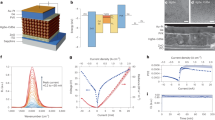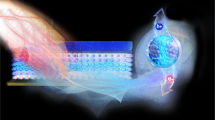Abstract
Today's infrared imaging devices are based on bulk and quantum-confined epitaxial materials and would benefit greatly from higher operating temperatures and lower cost. Imaging chips based on colloidal quantum dot technology could offer a convenient lower-cost alternative, but, to date, the spectral range of operation of colloidal quantum dots has been limited. In this Letter, we report colloidal HgTe quantum dot photodetectors with a room-temperature photoresponse beyond 5 µm, the longest interband absorption wavelength reported so far for colloidal materials. The photodetectors are fabricated from colloidal solutions, which are then drop-cast as thin films on electrodes. Operation covering the important atmospheric mid-wavelength infrared transparency window between 3 and 5 µm is demonstrated.
This is a preview of subscription content, access via your institution
Access options
Subscribe to this journal
Receive 12 print issues and online access
$209.00 per year
only $17.42 per issue
Buy this article
- Purchase on Springer Link
- Instant access to full article PDF
Prices may be subject to local taxes which are calculated during checkout





Similar content being viewed by others
References
Rogalski, A. Infrared detectors: an overview. Infrared Phys. Technol. 43, 187–210 (2002).
Rogalski, A., Antoszewski, J. & Faraone, L. Third-generation infrared photodetector arrays. J. Appl. Phys. 105, 091101 (2009).
Razeghi, M. Quantum dot infrared photodetectors. Technol. Quantum Dev. 395–423 (2010).
Canedy, C. L. et al. Controlling dark current in type-II superlattice photodiodes. Infrared Phys. Technol. 52, 326–334 (2009).
Konstantatos, G. & Sargent, E. H. Nanostructured materials for photon detection. Nature Nanotech. 5, 391–400 (2010).
Konstantatos, G. et al. Ultrasensitive solution-cast quantum dot photodetectors. Nature 442, 180–183 (2006).
Kim, H. et al. Optoelectronic characteristics of close-packed HgTe nanoparticles in the infrared range. Solid State Commun. 137, 315–319 (2006).
Böberl, M., Kovalenko, M. V., Gamerith, S., List, E. J. W. & Heiss, W. Inkjet-printed nanocrystal photodetectors operating up to 3 µm wavelengths. Adv. Mater. 19, 3574–3578 (2007).
Rauch, T. et al. Near-infrared imaging with quantum-dot-sensitized organic photodiodes. Nature Photon. 3, 332–336 (2009).
Guyot-Sionnest, P., Wehrenberg, B. & Yu, D. Intraband relaxation in CdSe nanocrystals and the strong influence of the surface ligands. J. Chem. Phys. 123, 074709 (2005).
Rogach, A. et al. Colloidally prepared HgTe nanocrystals with strong room-temperature infrared luminescence. Adv. Mater. 11, 552–555 (1999).
Rogach, A. et al. Colloidally prepared CdHgTe and HgTe quantum dots with strong near-infrared luminescence. Phys. Status Solidi B 224, 153–158 (2001).
Piepenbrock, M-O. M., Stirner, T., Kelly, S. M. & O'Neill, M. A low-temperature synthesis for organically soluble HgTe nanocrystals exhibiting near-infrared photoluminescence and quantum confinement. J. Am. Chem. Soc. 128, 7087–7090 (2006).
Li, L. S. et al. Room temperature synthesis of HgTe nanocrystals. J. Colloid Interface Sci. 308, 254–257 (2007).
Priyam, A., Blumling, D. E. & Knappenberger, K. L. Synthesis, characterization, and self-organization of dendrimer-encapsulated HgTe quantum dots. Langmuir 26, 10636–10644 (2010).
Kovalenko, M. V. et al. Colloidal HgTe nanocrystals with widely tunable narrow band gap energies: from telecommunications to molecular vibrations. J. Am. Chem. Soc. 128, 3516–3517 (2006).
Howes, P., Green, M., Johnston, C. & Crossley, A. Synthesis and shape control of mercury selenide (HgSe) quantum dots. J. Mater. Chem. 18, 3474–3480 (2008).
Kuno, M. et al. Molecular clusters of binary and ternary mercury chalcogenides: colloidal synthesis, characterization, and optical spectra. J. Phys. Chem. B 107, 5758–5767 (2003).
Chu, J. HgTe: lattice parameter, in (ed. Roessler, U.) SpringerMaterials — The Landolt-Börnstein Database (Springer-Verlag, 2008).
Yu, D., Wang, C. & Guyot-Sionnest, P. n-Type conducting CdSe nanocrystal solids. Science 300, 1277–1280 (2003).
Guenzer, C. S. & Bienenstock, A. Temperature dependence of the HgTe band gap. Phys. Rev. B 8, 4655–4667 (1973).
Dereniak, E. L. & Boreman, G. D. Infrared Detectors and Systems (Wiley-Interscience, 1996).
Rosencher, E. & Vinter, B. Optoelectronics (Cambridge Univ. Press, 2002).
Hooge, F. N. 1/f Noise Sources. NATO Science Series Vol. 151, 3–10 (Kluwer Academic Publishers, 2004).
Pourret, A., Guyot-Sionnest, P. & Elam, J. W. Atomic layer deposition of ZnO in quantum dot thin films. Adv. Mater. 21, 232–235 (2009).
Kovalenko, M. V., Scheele, M. & Talapin, D. V. Colloidal nanocrystals with molecular metal chalcogenide surface ligands. Science 324, 1417–1420 (2009).
Scofield, J. H. AC method for measuring low-frequency resistance fluctuation spectra. Rev. Sci. Instrum. 58, 985–993 (1987).
Acknowledgements
This research was supported by the US National Science Foundation (NSF; grant DMR-070626) and by the Department of Energy (grant DE-FG02-06ER46326). The authors made use of shared facilities supported by the NSF MRSEC Program (DMR-0820054). E.L. acknowledges the Ecole Polytechnique, Palaiseau, France, for a postdoctoral fellowship.
Author information
Authors and Affiliations
Contributions
S.K. made the materials and initiated photoconductivity measurements. E.L. studied the thermal-dependent properties. V.B. built the interferometer. P.G.S. guided the work and contributed, with S.K. and E.L., to writing the manuscript.
Corresponding author
Ethics declarations
Competing interests
The authors declare no competing financial interests.
Supplementary information
Supplementary information
Supplementary information (PDF 483 kb)
Rights and permissions
About this article
Cite this article
Keuleyan, S., Lhuillier, E., Brajuskovic, V. et al. Mid-infrared HgTe colloidal quantum dot photodetectors. Nature Photon 5, 489–493 (2011). https://doi.org/10.1038/nphoton.2011.142
Received:
Accepted:
Published:
Issue Date:
DOI: https://doi.org/10.1038/nphoton.2011.142
This article is cited by
-
Silver telluride colloidal quantum dot infrared photodetectors and image sensors
Nature Photonics (2024)
-
High-operating-temperature mid-infrared photodetectors via quantum dot gradient homojunction
Light: Science & Applications (2023)
-
Integrated photodetectors for compact Fourier-transform waveguide spectrometers
Nature Photonics (2023)
-
Mid-infrared single-pixel imaging at the single-photon level
Nature Communications (2023)
-
Wide-field mid-infrared single-photon upconversion imaging
Nature Communications (2022)



